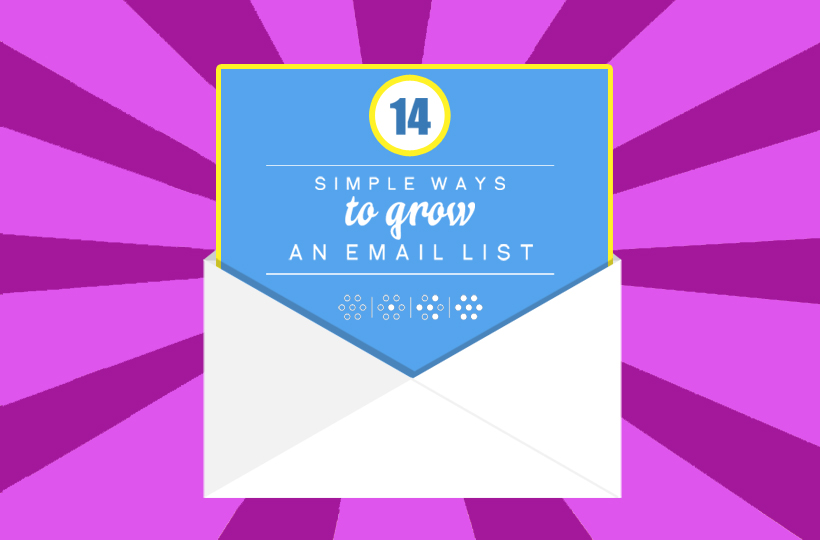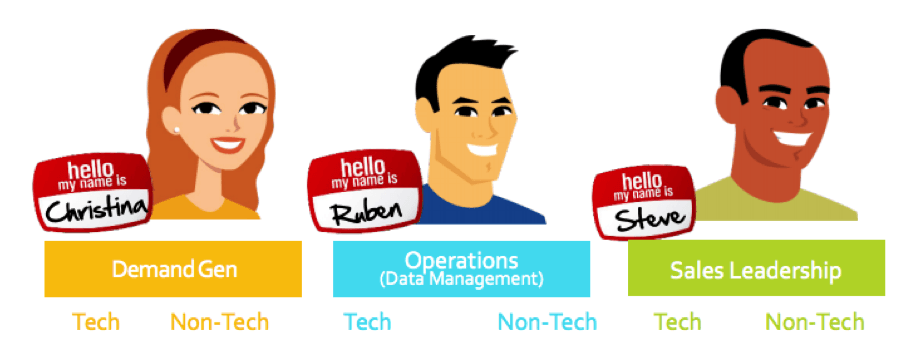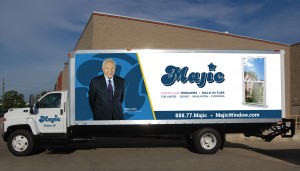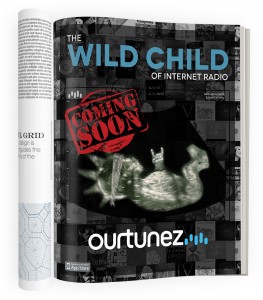
Email is still the most important component of any digital marketing mix. Even in today’s world with all kinds of different communication channels, email is still the easiest way to reach your audience. The fact of the matter is that email marketing is still largely regarded as the primary workhorse of digital marketing. This being said, your mailing lists are like marketing gold. Growing and nurturing your email subscribers should certainly be a top digital marketing priority, but maintaining your mailing list isn’t always easy. Did you know that marketing email databases typically degrade by roughly 25% per year? There are a lot of reasons for this decay. Your contacts could have changed jobs, opted out of your list, or simply switched email providers. This constant drop in following means it’s your job to keep your subscription numbers going in the right direction. How do you that? We have a few simple ideas for you.
Via Email
1) Encourage your subscribers to share and forward your emails
Incorporate social share buttons and an “Email to a Friend” button into every one of your marketing emails. That way you’ll have the potential to gain access to fresh networks, colleagues, and friends who might sign up for the mailing list. It’s important to also include a “Subscribe” CTA as a simple text-based link so that those receiving the forwarded emails can easily opt-in.
2) Create multiple email subscription types for a personalized touch
You’d be surprised at how far a little bit of personalization can go. Research by the Aberdeen Group has shown that personalized emails improve click through rates by 14%. They also increase conversions by 10%. Long story short, by creating multiple targeted subscription types you increase the probability that visitors will subscribe to one of them. So how do you go about adding a personalized touch? The first step is to identify the different personas of your target audience. When developing personas for your target audience there are 9 questions to consider.
- What is their demographic?
- What is their occupation and level of seniority?
- What does a day in their life look like?
- What are their pain points?
- What do they value most? What kind of goals do they have?
- Where do they go for information?
- What kind of shopping experience are they looking for?
- What are their most common objections for your products or services?
- How do you identify this persona?
As you reflect upon these questions you’ll begin to see clear distinctions between each persona. These distinctions highlight why it’s important to tailor your content and offers to match each unique persona. Once you have your different target audience profiles all fleshed out you can begin to craft unique personalized emails for each persona. NetProspex offers a great case study on the value of developing customer personas. Using a mix of website behavior and download history, they grouped their customers into the three distinct personas illustrated below.
Using all of the data collected, NetProspex then sent a series of more personalized emails to each persona. For example, if a lead’s activity identified them as a “Steve” then the firm knew the lead was more interested in sales leadership and they would be sent emails exclusively about sales leadership.
After implementing customer persona-based marketing, NetProspex saw a 111% increase in email open rates and a 171% increase in marketing revenue.
3) Reinvigorate a stale email list with an opt-in campaign
If you have an older email list that is mostly decayed you can breath new life into it by creating an engaging opt-in message and sending it out to your old list. You should encourage contacts to re-opt-in and promise to remove all contacts that don’t respond. It may seem counterintuitive to remove contacts in order to grow a contact list. Nonetheless, the logic checks out. Trimming inactive contacts out of your list could improve your deliverability and increase the odds that your email will be shared with contacts outside of your current database.
4) Add an opt-in link to your email signature
Create a link in your email signature that leads to a landing page. From the landing page give your visitors the ability to sign up for your mailing list. To increase the number of visitors to your landing page have all of your employees attach the opt-in link in their signatures as well.
Via Content
5) Create a new lead generating offer
Put together a free ebook or whitepaper and require visitors to provide their email address in order to download it. You can then promote your lead generating offers using your social media profiles. We’ve found Twitter to be one of the most successful social platforms for driving offer downloads.
6) Create a free online tool or resource
Much like the lead generating offer, you can have users sign up with their email address to access the tool or resource you’ve provided for them. One such example of a great lead generating tool would be HubSpot’s Marketing Grader. Marketing Grader analyzes a company’s marketing efforts across 30 different factors and provides an overall marketing grade on a scale of 1-100. Marketing Grader has been a huge success for HubSpot in generating hundreds of new email leads. Creating a new tool or resource for you business to promote may take a considerable amount of time to do, but the results will surely outweigh the costs.
Via Social Media
7) Promote an online contest
Create a free giveaway and promote it across your social media channels. Have users enter your contest by submitting their email address. If you’re new to creating a social contest, Social Media Examiner has a great article on how to run a successful social media sweepstakes. In terms of actually developing your contest page or social tab, we’ve found Shortstack to be one of our favorite free contest development tools.
8) Add a call to action to the top of your Facebook Page
Change your call to action button on the bottom right of your cover photo to link to a landing page. From that landing page require users to enter their email for access. Take a look at Shortstack’s use of their cover photo and CTA.
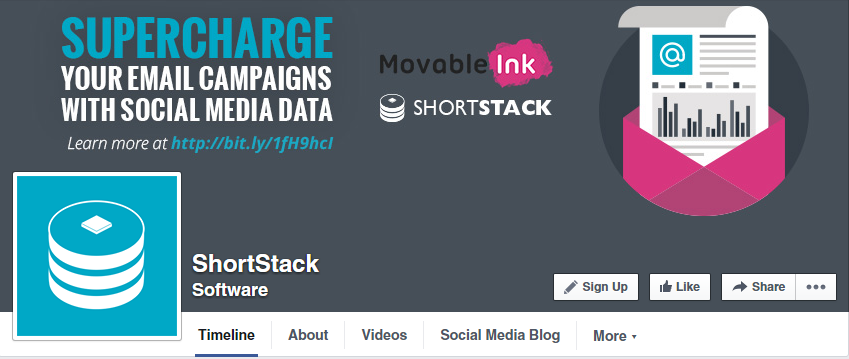
As you can see, Shortstack uses their cover photo to advertise for their free social media data webinar. Once a user clicks the sign up button they are lead to a landing page for the webinar. Users are prompted to enter their email to sign up for the webinar.
9) Leverage your YouTube Channel
Add calls to action in your videos to encourage people to subscribe to your lists. If your content is in a vlog format verbally remind your users to subscribe to your list if they like what they’re watching. Add a call to action in your video description and create annotations that link to relevant landing pages.
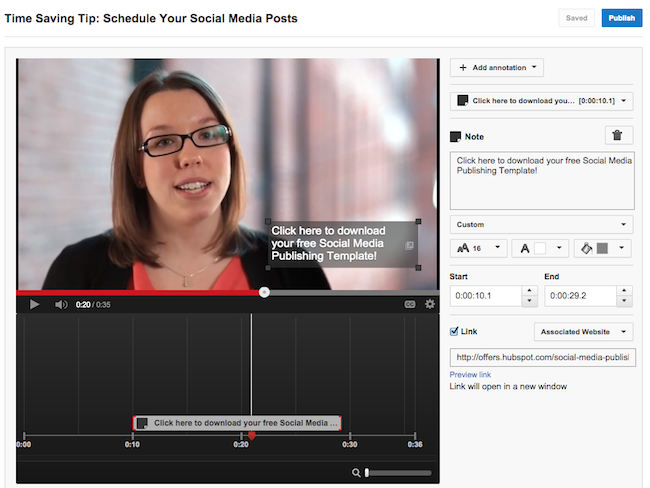
Via Your Website
10) Optimize your website offer links
Don’t make people dig around your site to stumble across subscription opt-ins. Keep your offers visible and include calls to action on as many pages of your website as possible. Some key places to consider placing subscription links are your homepage, about page, contact page, and the main page of your blog.
11) Craft a popup subscription form that actually works
Popup subscription forms are a marketing tool that are dreaded by both marketer and users alike. They are typically intrusive, with inconsistent branding, and off putting sales language. However, there’s a reason popup subscription forms are so prevalent across the web. It’s because they actually work! The trick is to design your forms in such a way that won’t drive your visitors crazy. Creating a subscription popup is all about striking a balance between your needs (a bigger email list) and your visitor’s needs (a peaceful browsing experience). There are two variables that come into play here, timing and offer. You don’t want your popup to initiate immediately after a user has landed on your page. They won’t want to subscribe to an email list when they don’t even know what your company has to offer. We’ve found the optimal time to be somewhere between 5 and 10 seconds. You’ll also want to craft some kind of offer or benefit users can receive for signing up.
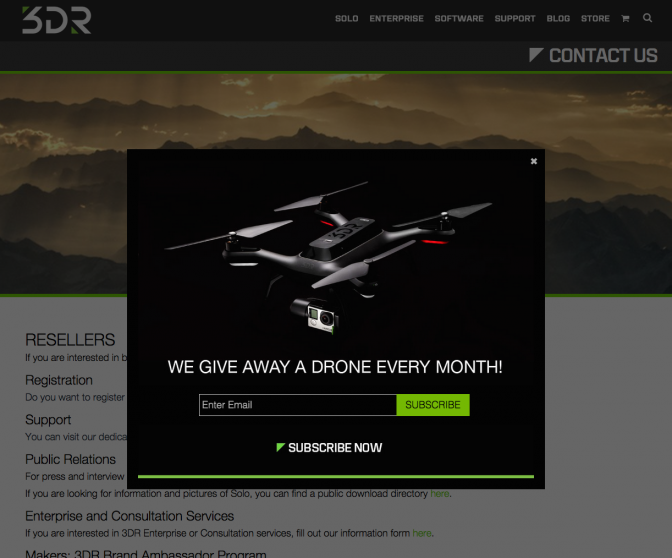
In the case of 3D Robotics, they promoted their drone giveaway which entices users to sign up for a chance to win a free drone. 3D Robotics has found some great success with their website popup. Currently, 5% of all new visitor to the site subscribe to the email list via the popup form. The popup form brings in more subscriptions than any other link on the site.
Via Traditional Marketing/Advertising
12) Leverage QR codes in your print material
You can add QR codes to your print marketing material so that people can scan to opt-in to your email list.
13) Collect email addresses at networking events
Don’t be afraid to push email subscriptions at offline networking events like trade shows. Much like your print material, you could add an opt-in QR code to your business card. If there aren’t any upcoming events worth attending you could always host your own meetups, conferences, educational panels, etc.
14) Add calls to action in your traditional campaigns
Include a shortened opt-in URL link with UTM parameters into your direct mail and other traditional campaigns. Encourage your audience to follow the link and subscribe to your emails so they can receive communications via email in place of direct mail. Give them the opportunity to opt-out of your direct mailing list once they opt-in to your email list. You’ll even save a few trees in the process.
In Conclusion
If you put all 14 of these ideas into practice your email list has the potential to grow dramatically. Of course, after obtaining a new subscription, the next step in the conversion cycle is to create great content that increases open and click through rates and prevents unsubscriptions. In order to whip your emails into shape, make sure to take a look at our blog post on the 10 elements for successful email marketing. Looking to run an email marketing campaign without having to put in any of the time or effort involved? Contact us to find out what Tipping Point can do for you.
